

Gibson had a long history of producing guitar amplifiers, and although some of these were pretty good, they never had the commercial success of their main rivals (Fender); or indeed of their guitars. The cycle of design, launch, and demise of amp series a total contrast to the continuity of Fender models such as the Twin Reverb. In the mid 1970s, a new tranche of Gibson products were envisaged, bringing in the latest innovations in electronics, courtesy of another Norlin company, Moog. Guitars, like the Gibson RD series combined Moog electronics with Gibson design and luthiery, whilst the Lab Series amplifiers, were designed exclusively by Moog, but marketed by Gibson. Technically LAB Series was a brand in its own right, but with the Gibson name on the vast majority of advertising, they are often considered Gibson amplifiers.
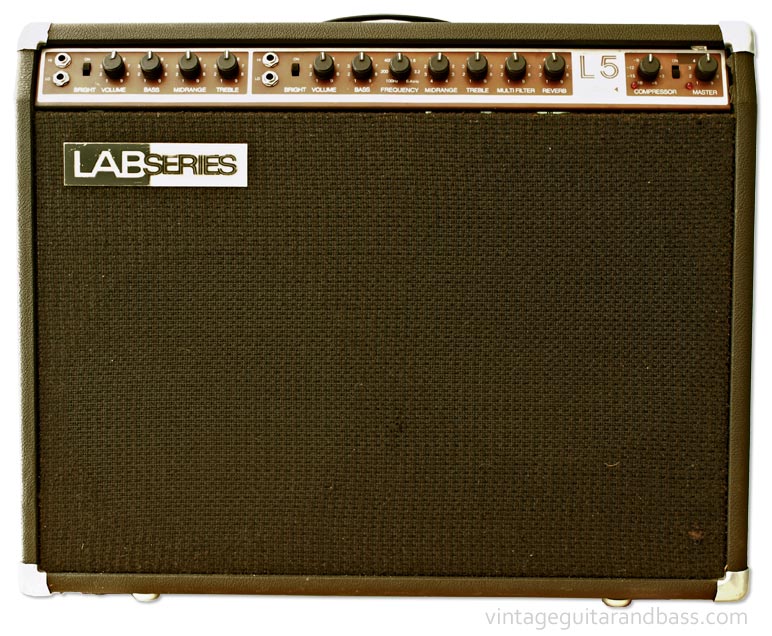
The 100w 2x12" Lab Series L5
The rationale behind the Lab Series was a line of high-end solid-state guitar and bass (and latterly keyboard) amplifiers, in competition to amps like Fender Twin Reverb and the Roland JC 120. And they were pretty successful (especially the Lab Series L5) with a lot of high profile users: B.B. king, Alan Holdsworth, Ronnie Montrose, Jimmy Messina, Gary Cooper and Bernie Marsden all appearing in contemporary advertising.
The models are summarised below:
| guitar amps | |||
| model | power | speakers | configuration |
| L3 | 60w | 1x12" | combo |
| L5 | 100w | 2x12" | combo |
| L7 | 100w | 4x10" | combo |
| L9 | 100w | 1x15" | combo |
| L11 | 200w | 2x4x12" | head + 2 cabs |
| bass amps | |||
| L2 | 100w | 1x15" | head + cab |
| L4 | 200w | 2x15" | head + cab |
| L6 | 100w | 1x15" | combo |
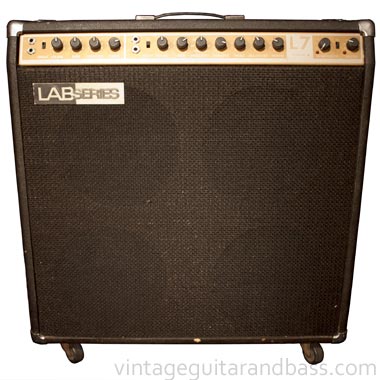
The 100w 4x10" Lab Series L7 guitar amplifier
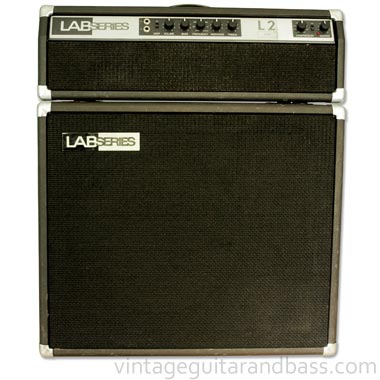
The 100w 1x15" Lab Series L2 bass amplifier
The controls for channel 1 were simple: volume, bass, mid and treble. Channel 2 was a bit more complicated, with controls described as follows. This diagram applies to the guitar amps L5, L7, L9 and L11. The bass amps were the same, but without the Multifilter and Reverb.

Hi for instruments with high-output pick-ups. Also cleaner sound. Lo for instruments with lower output pick-ups. Boosts signal. Also 'dirtier' sound.
Boosts treble response.
Adjusts gain of channel 2. Works in conjunction with master volume control.
Adjusts bass frequency response.
Works in conjunction with Midrange control. Scans audio frequencies the way a radio dial scans frequencies.
Works in conjunction with Frequency control. Adjust volume of octave band of frequencies that frequency control is centred on. (Set midrange at +4, sweep frequency control and listen to the mid range passing through the frequency range).
Adjusts treble frequency response.
Rearranges the upper harmonics to give valve-like or acoustic sound. Adds sparkle without harshness.
Controls amount of reverberation (channel 2).
(channels 1 & 2)
Limits and spreads final output power level without affecting harmonics and overload factors already in the signal. It's variable two. Result - capture that sustain and overdrive at the volume level you want. (With on/off switch and LED peak indicator)
Adjusts gain of entire amp (channels 1 & 2). Works in conjunction with separate channel volume controls.
Amplifier advertisements originally published from 1978 onwards. Click on the images for larger copies. Check out other vintage Gibson advertisements
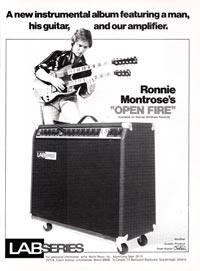
Gibson Lab Series L5 - A new instrumental album featuring a man, his guitar, and our amplifier (1978)
One of the earliest publicity pieces for the Lab Series amplifiers placed in mid 1978. Unlike the majority of adverts for these amplifiers to follow, this one is short on text, letting the images d...
[more]
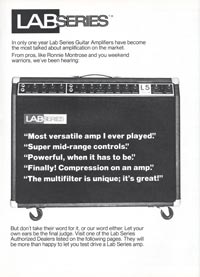
Gibson Lab Series L5 - LAB Series (1978)
June 1978 advertisement for the Lab Series amplifier range, picturing the 2x12" Lab Series L5 combo.
[more]
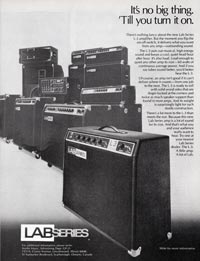
Gibson Lab Series L3 - It's no big thing. 'Til you turn it on. (1979)
March 1979 advert for a new amp in the Lab Series line up. The L3 was the smallest amp in the Lab Series range: a 60w combo with a single 12" speaker. It was also slimmed down in terms of controls....
[more]
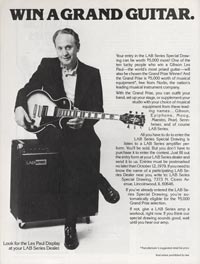
Gibson Lab Series amplifiers - Win a grand guitar (1979)
This ad features Mr. Les Paul equipped with a rather nice Les Paul Custom, and sitting on a Lab Series L7 (100w 4x10") amplifier. It was to promote a competition launched a few months earlier (June...
[more]
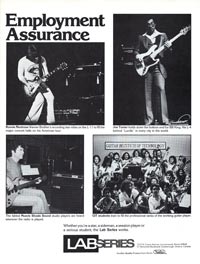
Gibson Lab Series L2 - Employment Assurance (1979)
"Whether you're a star, a sideman, a session player, or a serious student, the Lab Series works"
[more]
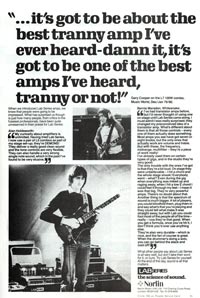
Gibson Lab Series L7 - It's got to be about the best tranny amp I've ever heard – damn it, it's got to be one of the best apps I've heard, tranny or not! (1980)
This 1980 advert for the Lab Series amplifier range was published in Guitar Player in 1980, and is made up of quotes by Gary Cooper (who proffered the title), Alan Holdsworth, and Whitesnake's Bern...
[more]
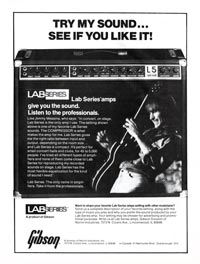
Gibson Lab Series L5 - Try my sound.. See if you like it! (1980)
This interesting advert from June 1980 features Jimmy Messina and the Lab Series L5. Like many of the other Lab Series ads, it includes quotes from the artist describing the amp, but also gives one...
[more]
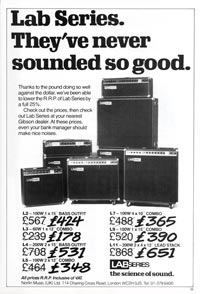
Gibson Lab Series L2 - Lab Series. They've never sounded so good (1980)
December 1980 United Kingdom advert for the Lab Series amplifiers - available at a big discount due to the favourable exchange rate. Models listed are the: L2 (100w 1x15" bass head/cabinet), L3 (60...
[more]
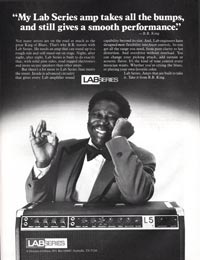
Gibson Lab Series L5 - "My Lab Series amp takes all the bumps, and still gives a smooth performance." (1981)
This Lab Series advert featuring bluesman B.B. King and his L5 appeared in Guitar Player magazine in May and August 1981 - just one of many 'artist' adverts for the amp line. King's bassplayer, Joe...
[more]

Gibson Lab Series amplifiers - Lab series. If only you could see how they sound. (1981)
One of the last Lab Series advertisements, from 1981, and one of very few printed in colour. The L-5 is pictured, but the text also highlights the 100w 1x15" L6 bass combo.
[more]
Subscribe to the vintageguitarandbass youtube channel for more vintage guitar and bass demos. Also, check out the other videos of these guitars in the supporting members area.
Find out more about these instruments here: 1981 Gibson Marauder, 1979 LAB series L7
The Marauder was quite atypical when it was first developed by Bill Lawrence for Gibson: with its maple fretboard and bolt-on neck. This clip shows a late period mahogany body, rosewood neck Gibson Marauder, played through a contemporaneous (actually 1979) 4x10 100w LAB series L7. The guitar is strung with Gibson bright wires (10-46). The L7 was created by Moog and Gibson (both Norlin companies) and is a seriously underated amp. The snarlier sounds are featured here, but it has a lot of really nice clean tones too. Watch the long version of this video in the vintageguitarandbass supporting members area, to hear a bit more of this guitar / amp under different settings.
There are three clips: first a demo of the pickup blend pot, then a clean/glassy tone demonstrating the LAB series midrange boost, and finally some really dirty fuzz from the lower boosted input. This amp has a HUGE range of sounds!
Recorded here with a Heil PR-40 (left channel) and a Shure SM57 (right channel), through a Focusrite Scarlett 2i2 interface - highly recommended gear!
Find out more about these instruments here: 1987 Gibson 20/20, LabSeries L2
The Gibson 20/20 is a superb playing instrument. It has a wide tonal range, is comfortable to play, and, frankly sounds immense. It's paired in this video, with a late 70s/early 80s Gibson/Norlin Lab Series L2 100w bass amp with 1x15 speaker. And this is an awesome (solid state) bass amp, designed by Bob Moog.
This video (part2) demonstrates some of the wide range of sounds you can get solely by adjusting the L2 midrange frequency control - and, to some extent, playing style.
As you can hear, just this one control has an enormous effect on the sound - the Lab series amps really are awesome, and hugely underrated
Recorded here with an Electrovoice RE-20 (left channel) and a Shure SM57 (right channel), through a Focusrite Scarlett 2i2 interface - highly recommended gear!
Find out more about these instruments here: 1987 Gibson 20/20, LabSeries L2
The Gibson 20/20 was not (visually, at least) to everyone's taste, but it is actually a superb playing instrument. It has a wide tonal range, is comfortable to play, and, frankly sounds immense. It's paired in this video, with a late 70s/early 80s Gibson/Norlin Lab Series L2 100w bass amp with 1x15 speaker. This video (part1) demonstrates the variance in instrument settings. Part 2 demonstrates some of the great sounds you can get by using the amps midrange frequency control.
Wonderful bass, brilliant amp: AWESOME combination.
Recorded here with an Electrovoice RE-20 (left channel) and a Shure SM57 (right channel), through a Focusrite Scarlett 2i2 interface - highly recommended gear!
$400
$200
$625
$1200
$550
$300
$250
$630
$300
€799
£105
£399